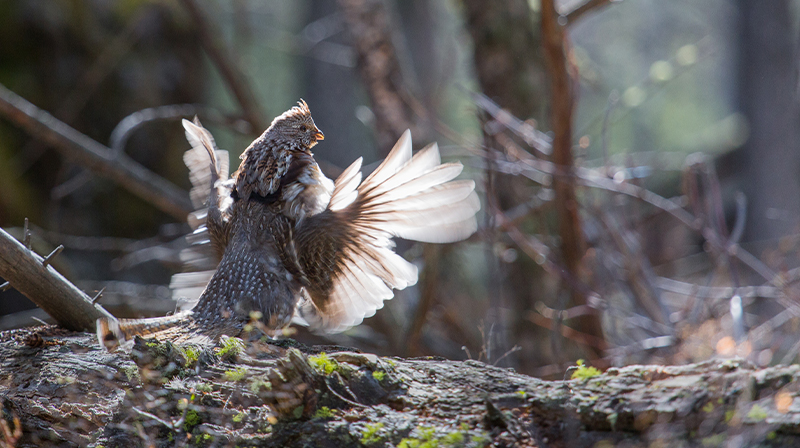
June 5, 2025 by Ruffed Grouse Society
Ruffed Grouse Society & American Woodcock Society (RGS & AWS) is proud to announce a major new investment in forest health and wildlife habitat across the Northeast. Through generous support from the National Fish and Wildlife Foundation’s 2025 Northeast Forests and Rivers Fund, we’ve been awarded a $274,340 grant to advance large-scale forest resilience and habitat management across 28,600 acres in northern New York and Vermont’s Champlain Valley. This work is part of a larger collaborative effort that leverages an additional $274,340 in matching contributions from partners and supporters.
At a time when Northeast U.S. forests are facing mounting pressures from fragmentation, invasive species and an alarming decline in habitat diversity and quality, this grant enables our team and our partners to implement proactive, science-based solutions at scale. Working through our long-standing partnership with Paul Smith’s College (PSC), as well as with the Trust to Conserve Northeast Forestlands, Vermont Agency of Natural Resources and Huntington Community Forest, we’ll advance landscape-level forest block planning, launch new habitat projects and engage hundreds of landowners, professionals and community members.
A Strong Foundation of Partnerships
This effort builds upon years of collaboration with public and private partners committed to restoring and stewarding the Northeast’s forests. RGS & AWS will work closely with PSC to enroll their 14,000-acre working forest in a comprehensive forest block plan, enhancing its role as a living laboratory for adaptive silviculture and habitat diversity. Together with PSC’s newly launched Institute of Forestry and its flagship Adirondack Watershed Institute, we will align fieldwork, student engagement and research to maximize impact.
State agencies, including the New York Department of Environmental Conservation and Vermont Fish & Wildlife Department, will provide vital support on public lands, helping to coordinate forest management efforts across key Wildlife Management Areas such as Fairfield Swamp and The Narrows in Vermont. Meanwhile, landowners surrounding these areas – representing over 57,000 acres already identified through NRCS’s Working Lands for Wildlife program – will continue to be engaged in habitat planning and restoration.
What This Project Will Deliver
With the support of NFWF and our funding partners, including the U.S. Fish and Wildlife Service, Sylvamo North America LLC and the American Forest Foundation, this project will:
- Improve habitat across 1,800+ acres, including 321 acres prioritized for Golden-winged warbler, American woodcock and ruffed grouse.
- Reach 200 participants through field workshops, volunteer events and outreach efforts
- Support two regional Master Logger trainings to promote professional excellence in sustainable forestry
Our work will strengthen habitat for at-risk species, improve water quality, support community forests and recreation and enhance climate resilience by managing for structural complexity and species diversity. This grant also helps catalyze additional resources and attention for conserving the Northeast’s iconic young forest habitat – essential for a range of declining wildlife.
Looking Ahead
RGS & AWS believes the best conservation outcomes happen when we align the needs of wildlife, forest ecosystems, landowners and local communities. This investment allows us to do just that – bridging science and practice, local action and regional vision. We extend our deep thanks to the National Fish and Wildlife Foundation, Sylvamo North America LLC, American Forest Foundation and all our project and funding partners. Together, we’re laying the groundwork for a healthier, more connected forest landscape that benefits wildlife and people for generations to come.
To learn more about our forest habitat initiatives in the Northeast, visit RuffedGrouseSociety.org/northeast-regional-page/.




